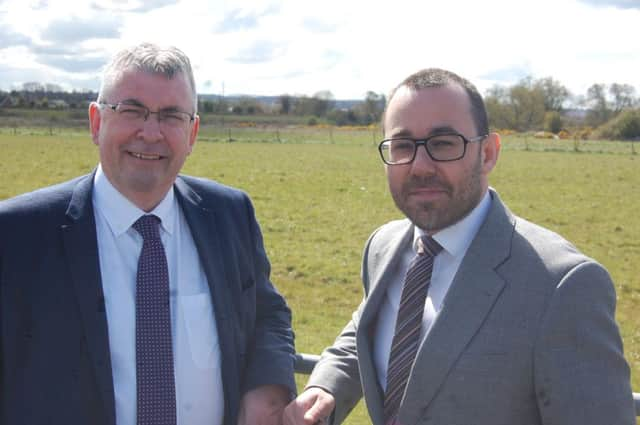'˜Not a lot of farmers know that'- SIPPs


In this case study we show how farmland can be purchased via a SIPP to release cash to a business.
Like many farmers, John has struggled to cope with the rising costs of livestock, and increasing prices for cereal.
Advertisement
Hide AdAdvertisement
Hide AdThey need a cash injection to their business but understand they can’t access pension funds until age 55. John’s family has been farming for generations and he wants to eventually hand over the farm to his son. His wife, Mary, has been working for many years on the farm helping John.
John and Mary are 45 and now they have an appointment to meet with Welby Associates to consider their options.
The SIPP option
Having conducted a full review of their circumstances and discussing different possibilities, a particular option appealed to John – a self-invested personal pension (SIPP). The adviser outlined the potential benefits of using a SIPP to purchase his own farmland. He explained it was possible to release some cash back – this appealed to John and Mary.
The adviser showed John that by consolidating his existing personal pension policies, totalling around £150,000, into a SIPP he could take greater control over his pension and retirement.
Advertisement
Hide AdAdvertisement
Hide AdDuring Mary’s years at work, she was pleased to find that during her years at work she had managed to accrue a £100,000 pension fund. Their adviser explained that between them they could purchase some of their farmland through a connected party transaction.
It was noted that the farmland and the associated commercial buildings could be purchased by the SIPP, but the family home and garden could not, and neither could any of the livestock or crops.
John asked about his farm machinery, but it was explained that it would not be feasible to invest in this, as it would incur significant tax charges on the SIPP.
Their adviser explained how the connected party transaction could work: he outlined how John and Mary could transfer their existing pension funds into SIPPs and then sell part of their farmland to these SIPPs at market value.
Advertisement
Hide AdAdvertisement
Hide AdHe recommends that John invest £100,000 of his SIPP into the property, and Mary £75,000. The rest of their pots could be invested elsewhere to ensure a more diversified portfolio.
The sale proceeds received from the SIPPs to John and Mary would increase the cash flow of the business to tide them over, allow them to invest in more machinery and other assets if required and help increase efficiencies on the farm.
The transaction would be classed as a disposal for capital gains tax (CGT) purposes and stamp duty land tax would be payable by the SIPPs on the purchase price.
John and Mary would enter a tenancy agreement with the SIPP provider and would have to pay a market rent for the land. The rent paid by the couple would be a tax deductible expense of their business and would also be received by the SIPP, free of any tax.
Advertisement
Hide AdAdvertisement
Hide AdAs the couple are nearing retirement, their adviser also discusses a clear succession plan for if one of them wanted to take their SIPP benefits at a different time to the other. They are both happy with this. They both like the idea that ultimately the land can be passed via their SIPP to their children under the new pension freedom rules.
Summary
The adviser showed both John and Mary how their financial positions would change purchasing the farmland using SIPPs.
Before
John and Mary both had various pension funds with a number of providers, totalling £250,000.
After
John and Mary both have SIPPs, which now own farmland with a total value of £175,000. £75,000 cash, less any CGT, has been released to them.
Advertisement
Hide AdAdvertisement
Hide AdThey pay an agreed market rent to the SIPPs for the land they farm.
Please note
Like most assets that may make up a pension fund, the value of commercial property can fall as well as rise.
Consideration should be given to the costs of both the SIPPs and the associated charges for them to acquire and manage the property. Fees are generally payable from the SIPP funds and are split proportionately between investors.
Commercial property is considered to be potentially illiquid. Unlike most traded assets it can take time to sell part or all of the asset.
Advertisement
Hide AdAdvertisement
Hide AdA good, robust succession plan drawn up at the outset can be effective in managing this situation, especially when the property owners are connected – they are either family or have a common interest in the investment.
If the investor is also the tenant, there is still liability for them to continue to pay rent even if experiencing financial difficulty.
The SIPP provider is obliged to chase tenants for rent even if they are the SIPP investor or a person or company connected to the investor.
When the investor chooses to take benefits, this may be at an inopportune moment in terms of value of the asset and that the value of the property/land is generally a matter of a valuer’s opinion rather than fact.
Advertisement
Hide AdAdvertisement
Hide AdWhere a property is owned on behalf of more than one investor, all investors will sign up to a group investment agreement. This sets out what will happen if an investor wishes to sell their share. A sale can take time and could affect when benefits are actually able to be taken.
If the property represents the main asset of the SIPP it would leave its investment holdings poorly diversified.
When selling part or all of a property to a SIPP provider the property is then under ownership of the provider.
Aodh can be contacted on 028 92622910.